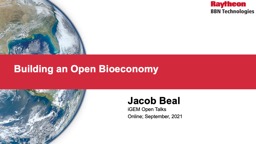

Jacob Beal iGEM Open Talks Online September 2021 Synthetic Biology is driving the bioeconomy Who is going to own it and who is it going to serve Balancing Open and Proprietary Good Proprietary ID: 1039800
Download Presentation The PPT/PDF document "Building an Open Bioeconomy" is the property of its rightful owner. Permission is granted to download and print the materials on this web site for personal, non-commercial use only, and to display it on your personal computer provided you do not modify the materials and that you retain all copyright notices contained in the materials. By downloading content from our website, you accept the terms of this agreement.
1. Building an Open BioeconomyJacob BealiGEM Open TalksOnline; September, 2021
2. Synthetic Biology is driving the bioeconomyWho is going to own it and who is it going to serve?
3. Balancing Open and ProprietaryGood Proprietary:Products & ServicesBad Proprietary:Control of InfrastructureEnabling Infrastructure
4. Why I almost quit synthetic biologyNice paper. Shame if anybody noticed your patent violations.
5. How do we ensure open infrastructure?Where has it worked?Network protocolsProgramming languagesServer softwareWeb browsersLarge organizations need themOpen markets, innovationWhere has it failed?App storesSocial mediaOnline salesAdvertising / searchDirect sales to consumersOligopolies, crashing marketsLibre ≠ GratisOpen infrastructure was never assured (c.f., Microsoft)Key: critical mass of pre-competitive value
6. SynBio is approaching a major transitionBioBricks GG, MoClo, BASIC, …Calibrated assays SNR, models, …Predictable Design[Endy, Science ‘05; Beal et al., TIBTECH ’18]2000s2010sNOW
7. with measurement errorwith model errorControl uncertainty enough for a reasonable chance of success…estimated property valuepredicted acceptable rangeBetterdevicesCalibratedmeasurementPragmaticmodelsThe Universal Foundation of Engineering
8. with measurement errorwith model errorestimated property valuepredicted acceptable rangeBetterdevicesCalibratedmeasurementPragmaticmodelsSynBio has the necessary ingredientsPromoter insulationHigh-SNR devicesPrecisionprediction[Davidsohn et al, ACS SynBio, ‘15; Sexton & Tabor, MSB ‘20; Carr et al., PLOS ONE, ‘17; Weinberg et al, Natcomm, ‘19, Beal et al., PLOS ONE, ‘18]
9. DesignBuildTestLearnDesign SpecificationCompleteDesignInterpretation& ModelsNA / StrainBuild PlanNA / StrainSamplesExperimentPlanAnalysisConfigurationData &Meta-DataLevel 0: No AutonomyLevel 1: Investigator AssistanceLevel 2: Partial AutonomyWhat are the barriers to integration?Looks pretty good?Level 3: Conditional Autonomy[Beal & Rogers, MSB ‘20]
10. DesignBuildTestLearnDesign SpecificationCompleteDesignComponentSpecificationsGoalsInterpretation& ModelsDomainKnowledgeProtocolSpecifications,InventoryExecutableProtocolsNA / StrainBuild PlanNA / StrainSamplesProtocolSpecifications,InventoryExecutableProtocolsExperimentPlanAnalysisConfigurationData &Meta-DataAnalyticalTool APIsLevel 0: No AutonomyLevel 1: Investigator AssistanceLevel 2: Partial AutonomyHidden cost: curation & configuration[Beal & Rogers, MSB ‘20]Level 3: Conditional Autonomy
11. SBOL 3: Representing the whole system[Baig et al., JIB ’20, McLaughlin et al., FBB ‘20]
12. Agile Data CurationAgile software tools:Distributed version controlAutomated buildContinuous integrationIssue tracking / boardsGitFlow & pull request reviewsBiological knowledge resources:Maintain integration, automate checklists focus on scienceBio DBTL as code & logs
13. Example: iGEM 2022 DistributionGitflow Agile workflow: Pull requests & change reviewGitHub ActionsValidation pipelineCollation & extractionResult: focus on design content, not sequence collation
14. What you can do to helpChoose open market business modelsChoose free and open licensesUse open standardsDevelop open infrastructureAdopt agile curation practicesCalibrate and share your data and modelsUse other people’s data, protocols, models, toolsContribute to open toolsAutomate a little bit more every timeThe three chief virtues of a programmer are: Laziness, Impatience and Hubris- Larry Wall